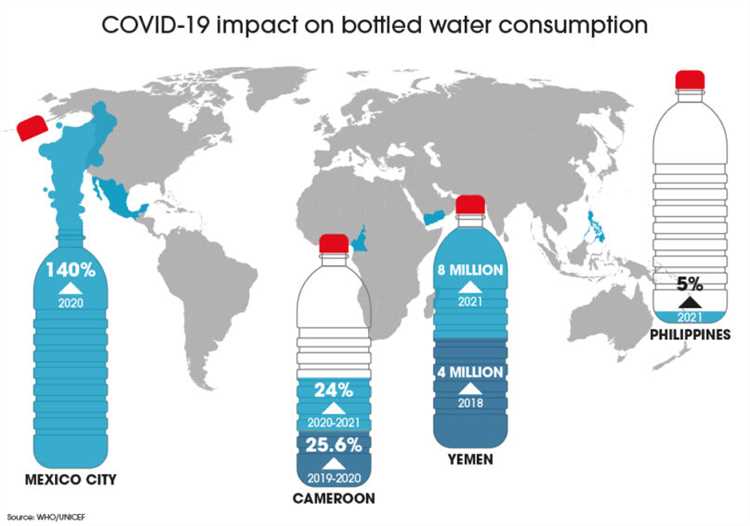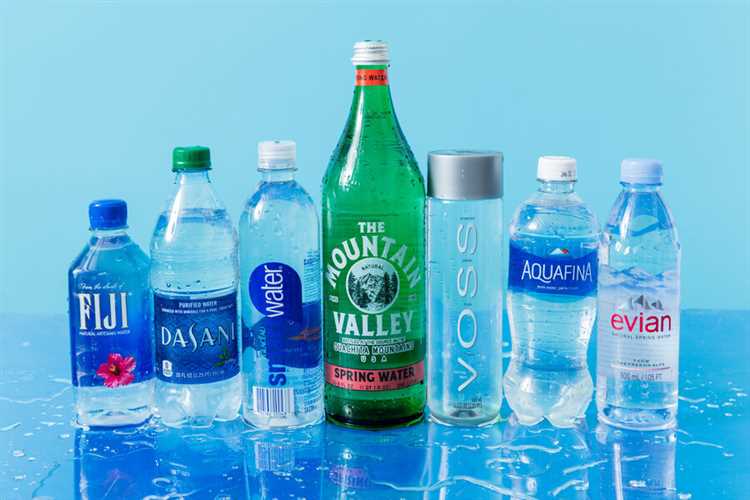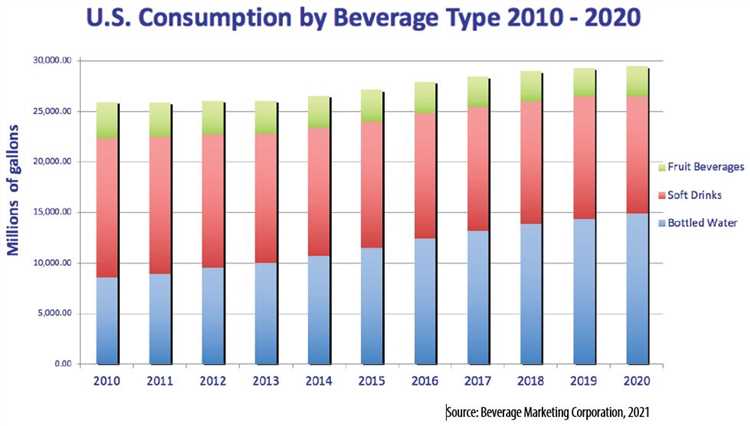
When it comes to bottled water consumption, there are some countries that stand out from the rest. The demand for bottled water has been on the rise worldwide, but which countries are the largest consumers? Let’s take a closer look at the top consumers of bottled water and explore the reasons behind their thirst.
One of the leading countries in bottled water consumption is the United States. Americans have embraced the convenience and portability of bottled water, making it a popular choice for hydration. With a bustling lifestyle and a focus on fitness and health, it’s no wonder that Americans turn to bottled water as a quick and easy way to stay hydrated on the go.
Another top consumer of bottled water is China. As one of the most populous countries in the world, China faces challenges with water quality and safety. Bottled water provides a reliable and trusted source of clean drinking water for many Chinese citizens. Additionally, the rising middle class in China has increased disposable incomes, allowing more people to afford bottled water as a premium product.
Other countries that rank high in bottled water consumption include Mexico, Brazil, and Indonesia. These countries often face similar challenges with water quality and safety, driving the demand for bottled water. Additionally, cultural preferences and habits also play a role in the popularity of bottled water in these countries.
In conclusion, the top consumers of bottled water are often countries with a high demand for safe and convenient drinking water. Whether driven by lifestyle choices, concerns about water quality, or cultural preferences, these countries have embraced bottled water as a popular choice for hydration.
- The United States: Leading the Way in Bottled Water Consumption
- Factors driving the high consumption
- Environmental impact and sustainability
- China: Rising Demand for Bottled Water
- Population Growth
- Water Safety Concerns
- Brazil: A Growing Market for Bottled Water
- Mexico: High Bottled Water Consumption Rates
- Bottled Water Brands in Mexico
- Environmental Concerns
- Indonesia: Increasing Trend of Bottled Water Consumption
- Factors Driving the Increase
- Market Players and Competition
- India: Emerging Market for Bottled Water
- Question-answer:
- Who are the top consumers of bottled water?
- Why is bottled water so popular?
- What factors contribute to the high consumption of bottled water in the United States?
- What are the environmental impacts of the high consumption of bottled water?
- Are there any alternatives to bottled water?
- What is the most consumed bottled water brand?
The United States: Leading the Way in Bottled Water Consumption
When it comes to consuming bottled water, no country can rival the United States. With its vast population and widespread access to clean drinking water, Americans have embraced bottled water as a convenient and healthy hydration option.
Factors driving the high consumption
There are several factors contributing to the United States’ position as the top consumer of bottled water:
- Convenience: Americans lead busy lifestyles and often rely on quick and portable beverage options. Bottled water provides an easy solution for staying hydrated on the go.
- Health concerns: Many Americans are concerned about the quality of tap water and choose bottled water as a perceived safer alternative.
- Marketing and advertising: The bottled water industry in the United States has invested heavily in marketing and advertising campaigns, promoting the benefits of drinking bottled water.
Environmental impact and sustainability
However, the high consumption of bottled water in the United States also raises concerns about its environmental impact. The production and disposal of plastic bottles contribute to pollution and waste.
Efforts are being made to address these concerns, with an increasing emphasis on recycling and the development of more sustainable packaging options. Additionally, many Americans are starting to embrace reusable water bottles as a more eco-friendly choice.
Despite these challenges, the United States continues to lead the way in bottled water consumption. With the growing awareness of environmental issues, there is a potential for changes in consumer behavior and a shift towards more sustainable alternatives in the future.
China: Rising Demand for Bottled Water
China has seen a significant increase in the demand for bottled water in recent years. With its growing population and concerns about tap water quality, more and more Chinese consumers are turning to bottled water as their main source of hydration.
Population Growth
China, the world’s most populous country, has an ever-increasing population. As urbanization continues, access to clean and safe drinking water has become a major concern for many individuals and families. In densely populated cities, tap water quality is often a cause for worry due to issues such as pollution and outdated infrastructure.
The rising population has also led to increased consumer purchasing power, allowing more people to afford the convenience and perceived health benefits of bottled water.
Water Safety Concerns

Water safety has become a significant concern in China due to incidents of contamination and pollution. Some regions have experienced high levels of industrial waste, agricultural runoff, and chemical contaminants in their water sources. As a result, people are becoming more cautious about consuming tap water and are turning to bottled water as a safer alternative.
Additionally, several health scares involving tap water in recent years have further fueled the demand for bottled water. These incidents have led to a loss of public trust in the quality of tap water, pushing consumers to opt for bottled water instead.
To meet the growing demand, both domestic and international bottled water brands have expanded their presence in the Chinese market. Many companies have introduced innovative products and marketing strategies tailored to the preferences and needs of Chinese consumers.
| Year | Bottled Water Consumption (Liters per Capita) |
|---|---|
| 2015 | 45 |
| 2016 | 51 |
| 2017 | 56 |
| 2018 | 61 |
| 2019 | 67 |
The table above shows the steady increase in bottled water consumption in China over the years. This upward trend demonstrates the growing preference for bottled water among Chinese consumers.
In conclusion, China’s demand for bottled water has been on the rise due to factors such as population growth and concerns about water safety. As the market continues to expand, there are opportunities for both local and international companies to capitalize on the growing demand and cater to the specific needs of Chinese consumers.
Brazil: A Growing Market for Bottled Water

Brazil has emerged as one of the fastest growing markets for bottled water in recent years. With its vast population and increasing urbanization, the demand for clean and safe drinking water has skyrocketed.
One of the main reasons for the growing popularity of bottled water in Brazil is the poor quality of tap water in many regions. The lack of infrastructure and contamination issues have created a sense of distrust among consumers, leading them to seek alternative sources of drinking water.
Another key factor driving the growth of the bottled water industry in Brazil is the rising health consciousness among the population. As more people become aware of the importance of hydration and the benefits of drinking water, they are turning to bottled water as a convenient and reliable option.
The Brazilian market offers a wide range of bottled water options, including natural spring water, purified water, and flavored water. Consumers have the freedom to choose according to their preferences and dietary needs.
Major global and local players in the bottled water industry have recognized the potential of the Brazilian market and are actively expanding their operations in the country. This has led to increased competition and innovation, with companies introducing new products and marketing strategies to attract consumers.
In addition to domestic consumption, Brazil has also become a significant exporter of bottled water. The country’s high-quality water sources and strict quality control standards have made Brazilian bottled water highly sought after in international markets.
Despite the impressive growth, the Brazilian bottled water market still has untapped potential. As the country continues to develop, the demand for clean and safe drinking water will only increase. This presents a lucrative opportunity for both existing and new players in the industry.
In conclusion, Brazil is experiencing a boom in the bottled water market, driven by factors such as poor tap water quality, increasing health consciousness, and a wide range of product options. With its growing population and expanding urbanization, the demand for bottled water is set to continue rising in the coming years.
Mexico: High Bottled Water Consumption Rates
Mexico has one of the highest rates of bottled water consumption in the world. The demand for bottled water in Mexico has been steadily increasing over the years due to various factors such as concerns about tap water quality, convenience, and a lack of trust in the public water supply.
One of the main reasons for the high consumption rates is the perception that tap water in Mexico is not safe to drink. Despite efforts by the Mexican government to improve water infrastructure and treatment processes, many people still prefer to rely on bottled water as a precautionary measure. This is particularly true in rural areas where access to clean drinking water is limited.
In addition to concerns about water quality, the convenience of bottled water also plays a significant role in the high consumption rates. Bottled water is readily available in Mexico, and the affordability of bottled water makes it an attractive option for many consumers. It is common to see people carrying bottles of water with them wherever they go, including restaurants, schools, and public transportation.
Bottled Water Brands in Mexico
There are several popular bottled water brands in Mexico that dominate the market. Some of the well-known brands include:
| Brand | Market Share |
|---|---|
| Bonafont | 33% |
| Ciel | 22% |
| Epura | 17% |
| Santa Maria | 12% |
These brands offer a variety of bottle sizes and types, catering to different consumer preferences.
Environmental Concerns
The high consumption rates of bottled water in Mexico also raise concerns about environmental sustainability. The production and disposal of plastic bottles have significant environmental impacts, including pollution and the depletion of non-renewable resources.
Efforts are being made to address these concerns, such as encouraging the use of reusable water bottles and improving recycling infrastructure. However, changing consumer behavior and reducing plastic waste remains a challenge.
In conclusion, Mexico’s high consumption rates of bottled water can be attributed to concerns about water quality, convenience, and a lack of trust in the public water supply. While efforts are being made to address environmental concerns, the demand for bottled water continues to remain high in Mexico.
Indonesia: Increasing Trend of Bottled Water Consumption
Indonesia is experiencing a significant increase in the consumption of bottled water in recent years. As more people have access to clean drinking water, the demand for bottled water has steadily grown.
Factors Driving the Increase
There are several factors driving the increasing trend of bottled water consumption in Indonesia:
- Rising Urbanization: As Indonesia’s urban population continues to grow, there is a greater demand for convenient and portable drinking water. Bottled water provides a convenient solution for individuals who are constantly on the go.
- Health and Safety Concerns: The public’s growing awareness of water pollution and contamination has led to an increased demand for safe and clean drinking water. Bottled water is often perceived as a safer alternative to tap water.
- Changing Lifestyles: With the rise of the middle class in Indonesia, there has been a shift in lifestyle preferences. Bottled water is seen as a symbol of status and modernity, leading to its increased consumption.
Market Players and Competition
The bottled water market in Indonesia is highly competitive, with both domestic and international players vying for market share. Some of the key market players include Aqua, Cleo, Pristine, and Nestle. These companies offer a variety of packaging options and water sources to cater to different consumer preferences.
In conclusion, Indonesia is seeing a significant increase in bottled water consumption due to factors such as rising urbanization, health and safety concerns, and changing lifestyles. The market is highly competitive, with various players offering a range of products to meet consumer demands.
India: Emerging Market for Bottled Water
India has recently emerged as one of the fastest-growing markets for bottled water. With a population of over 1.3 billion people, the demand for clean and safe drinking water has skyrocketed in recent years. Rapid urbanization, increasing disposable incomes, and a growing awareness of the health benefits of consuming clean water have all contributed to the rise in the consumption of bottled water in India.
The bottled water industry in India has witnessed tremendous growth, with both domestic and international players entering the market to meet the rising demand. Major players in the industry have invested heavily in production, distribution, and marketing to tap into this lucrative market.
One of the key drivers of the growth in the Indian bottled water market is the lack of access to safe drinking water in many parts of the country. Contamination of water sources due to industrial pollution, inadequate sanitation systems, and poor infrastructure have led to a rise in waterborne diseases. As a result, consumers are turning to bottled water as a safer alternative.
Another factor contributing to the popularity of bottled water in India is the increasing trend of health-consciousness among consumers. Bottled water is seen as a healthier choice compared to tap water, as it is perceived to be free from pollutants and contaminants. This has led to a shift in consumer preferences, with more people opting for bottled water for their daily hydration needs.
The Indian government has also played a role in promoting the consumption of bottled water. In recent years, the government has launched campaigns to raise awareness about the importance of clean water and the benefits of consuming bottled water. It has also implemented regulations to ensure the quality and safety of bottled water products.
| Benefits of Bottled Water in India |
|---|
| 1. Safe and clean drinking water |
| 2. Convenient packaging |
| 3. Healthier choice compared to tap water |
| 4. Variety of options available |
In conclusion, India has emerged as a promising market for bottled water, driven by factors such as the lack of access to safe drinking water, increasing health consciousness among consumers, and government initiatives. The bottled water industry in India is expected to continue growing in the coming years, as the demand for clean and safe drinking water remains high.
Question-answer:
Who are the top consumers of bottled water?
The top consumers of bottled water are the United States, Mexico, China, Brazil, and Indonesia.
Why is bottled water so popular?
Bottled water is popular because it is convenient, portable, and perceived as being cleaner and safer than tap water in some areas.
What factors contribute to the high consumption of bottled water in the United States?
The high consumption of bottled water in the United States can be attributed to factors such as a distrust of tap water quality, concerns about health and safety, and the convenience of bottled water for on-the-go lifestyles.
What are the environmental impacts of the high consumption of bottled water?
The high consumption of bottled water leads to significant environmental impacts, including the production of plastic bottles, energy usage for production and transportation, and the generation of waste from discarded bottles.
Are there any alternatives to bottled water?
Yes, there are several alternatives to bottled water, including using reusable water bottles, installing water filters at home, and drinking tap water if it is safe and approved by local authorities.
What is the most consumed bottled water brand?
The most consumed bottled water brand globally is Aquafina, followed by Dasani and Nestle Pure Life.